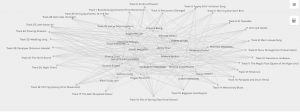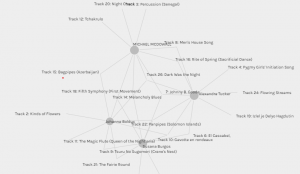Week 9: Network Assignment
The first thing I noticed about this visual representation of data was what appeared to be an absence of consensus on the song choices: 26 of 27 songs were selected by some member of the class, with the exception of “Izlel e Delyo Hagdutin” (so much for bagpipe-accompanied, underdog hero songs). Overall, our group agreed with 26 of the original 27 song choices made in 1977. I pried away at the model to look for groupings or patterns I could establish by manipulating the positions of nodes. I chose songs that 4 people commonly chose, then looked for other songs that they may have also chosen as a collective. My attempt to construct correlations didn’t go very far. On their site, Palladio’s creators describe the tool as intended for “humanistic practices”. It is certainly, as they put it, “an environment that supports thinking through data.” I concluded that this model illustrated a kind of hive brain that existed when everyone’s individual choices could be considered to equitably determine the best choices of songs.

As I took their advice and thought through this data, I wasn’t very convinced by the 5 groups that the program generated. I looked at the songs each group had in common, and rarely did they have two songs that they achieved consensus on. I named the groups by their song choices, two of which were “Blues Group” and the “Classical Group”. Three blues-related songs appeared to unite the first group, while “Rite of Spring” and “String Quartet No. 13 in B flat” appeared to unit the second. On closer examination, it seemed unlikely that this was a strong basis on which to form these groups. The implications are a little worrisome, in that the 5 group viewings create the appearance of difference that isn’t as obvious in the whole cluster. I tried making my own group based on track 3 – Percussion (Senegal). The only other common song choice was the class favourite: (24) “Flowing Streams”. To call us a group seemed a distortion of what was there, despite the allure of the visual. I recognize how this could function as a tool to assist in “instill[ing] literacy about how algorithms function in the general public.” I was constantly required to make sense of what was presented, rather than view it as conclusive. It also brought to mind Marc Rotenberg’s comments about how important it is for algorithms to have transparency instead of opacity. I aligned this idea with my ability to pry apart what I wanted in the models and reconfigure them.

I looked more closely at the song choices my name was connected to. They often did not match the song choices I believed I had made in the quiz—which were based on the ten songs I chose for my reflection in week 8. I suspected this must have been due to an error in data entry—I figured it was my own, but it seemed suspicious. I knew I’d chosen “Johnny B. Goode”, for example, but it was not represented in the visual. It threw into question for me just how accurate the whole display was. I looked at the group I thought I was part of, and realized it was nothing of the sort. If the outcome is only as good as the data going into the algorithm, then it takes active participation to recognize whether the data are accurate. I suspect corporations like Google or Facebook are not going to be forthcoming about how their algorithms actually work. In the case of Facebook, it is concerning that Instagram is set up in a way that leads users to extreme content in the name of maintaining viewership. One wonders what would happen if such information about their recommending algorithm been made clear to policymakers. It serves as useful reminder that, if the public wants to understand what a given company is doing, they will need to demand policies that insist on transparency as a condition of operation.
References
Palladio Project (n.d.). About. http://hdlab.stanford.edu/palladio/
Rainie, L. & Anderson, J. (2017, February 8). Code-Dependent: Pros and Cons of the Algorithm Age. Pew Research Center. https://www.pewresearch.org/internet/2017/02/08/code-dependent-pros-and-cons-of-the-algorithm-age/